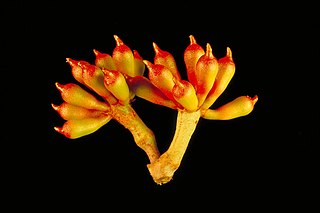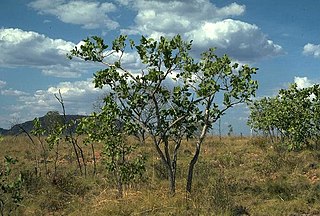
Eucalyptus pleurocarpa, commonly known as tallerack, talyerock or tallerack is a species of mallee that is endemic to the southwest of Western Australia. It has smooth bark, broadly lance-shaped to elliptical, grey or glaucous leaves that are arranged more or less in opposite pairs, flower buds in groups of seven, whitish flowers and glaucous, barrel-shaped fruit. It is easily recognised in the field by its form, large, white, waxy leaves and, when in flower, its stamens clustered in four groups.

Eucalyptus krueseana, commonly known as book-leaf mallee, is a mallee that is endemic to inland Western Australia. It has smooth bark that is shed in ribbons, a crown of sessile, juvenile leaves, glaucous flower buds and greenish yellow flowers.

Eucalyptus pulverulenta, commonly known as silver-leaved mountain gum, is a species of straggly tree or mallee that is endemic to southern New South Wales. It has smooth bark, egg-shaped, heart-shaped or round, sessile leaves arranged in opposite pairs, flower buds in groups of three, white flowers and cup-shaped to cylindrical fruit.

Eucalyptus kartzoffiana, commonly known as the Araluen gum, is a species of medium-sized tree that is endemic to a small area of southeastern New South Wales. It has rough, fibrous or flaky bark on part or most of its trunk, lance-shaped or curved adult leaves, flower buds in groups of three, white flowers and sessile, bell-shaped fruit.

Eucalyptus rhodantha, commonly known as rose mallee, is a species of straggly mallee or shrub that is endemic to Western Australia. It has smooth bark, a crown composed entirely of heart-shaped, sessile juvenile leaves arranged in opposite pairs, single flower buds in leaf axils, red flowers and pendent, hemispherical to conical fruit.

Corymbia zygophylla, commonly known as the Broome bloodwood, is a species of small tree or a mallee that is endemic to Western Australia. It has rough, tessellated to fibrous bark on the trunk and branches, a crown of juvenile heart-shaped to lance-shaped, stem-clasping leaves, flower buds in groups of three or seven, white flowers and urn-shaped to shortened spherical fruit.

Eucalyptus burdettiana, commonly known as Burdett gum or Burdett's mallee, is a species of flowering plant in the family Myrtaceae and is endemic to Western Australia. It is a mallee or shrub with smooth bark, lance-shaped adult leaves, flower buds with an elongated horn-shaped operculum, greenish-yellow flowers and cup-shaped or bell-shaped fruit.

Eucalyptus herbertiana, commonly known as Kalumburu gum or yellow-barked mallee, is a species of small tree or mallee that is endemic to northern Australia. It has smooth bark, lance-shaped or curved adult leaves, flower buds in groups of seven, white flowers and cup-shaped, hemispherical or conical fruit.

Eucalyptus houseana, commonly known as Kimberley white gum, or is a species of medium-sized tree that is endemic to the Kimberley region of Western Australia. It has smooth bark, lance-shaped adult leaves, flower buds in groups of seven, white flowers and conical to hemispherical fruit.

Eucalyptus newbeyi, commonly known as Beaufort Inlet mallee, is a species of mallee that is endemic to a small area on the south coast of Western Australia. It has smooth, mottled bark, narrow leaves, flower buds usually in groups of seven, yellowish green flowers and bell-shaped to conical fruit.
Eucalyptus ordiana is a species of small tree or a mallee that is endemic to the Kimberley area of Western Australia. It has smooth, powdery bark, egg-shaped leaves, flower buds in groups of seven, white flowers and cup-shaped fruit.

Eucalyptus pantoleuca, commonly known as round-leaved gum or Panton River white gum, is a species of small tree that is endemic to the Kimberley region of Western Australia. It has smooth, powdery bark, more or less round adult leaves, flower buds in groups of three, white flowers and conical fruit that are glaucous at first.
Eucalyptus pruiniramis, commonly known as Jingymia gum or midlands gum is a species of mallee or tree that is endemic to a small area of Western Australia. It usually has rough bark on the lower half of the trunk, smooth bark above, dull green, lance-shaped adult leaves, flower buds in groups of between seven and eleven, white flowers and cylindrical to cup-shaped fruit.

Eucalyptus pruinosa, commonly known as silver box, silver leaf box, apple box or smoke tree, is a species of tree or a mallee that is endemic to northern Australia. The Jaminjung peoples know the tree as yarrirra or jarnbiny, the Jaru as wararn and the Wagiman as wararn. It has rough, fibrous to flaky bark on the trunk and branches, a crown composed of juvenile, glaucous, heart-shaped to broadly elliptical leaves arranged in opposite pairs, flower buds arranged in groups of seven on the ends of branches, creamy white to pale yellow flowers and cylindrical to conical fruit.

Corymbia abbreviata, also known as the scraggy bloodwood, is a species of straggly tree that is native to Western Australia and the Northern Territory. It has rough bark, a crown of stiff leaves arranged in opposite pairs, flower buds usually in crowded groups on the ends of branchlets and urn-shaped fruit.

Eucalyptus ceracea also known as the Seppelt Range gum or Seppelt Range yellow-jacket, is a species of small tree or mallee that is endemic to a small area in the north of Western Australia. It has thick, fibrous or flaky bark on the trunk and larger branches, dull, glaucous, egg-shaped leaves arranged in opposite pairs, flower buds in groups of seven or nine, bright orange flowers and urn-shaped fruit. The leaves, buds and fruit are covered with a white wax.

Eucalyptus crucis is a species of mallee that is endemic to Western Australia. There are three subspecies, commonly known as silver mallee or Southern Cross mallee,, narrow-leaved silver mallee, and Paynes Find mallee,. It has rough bark that is shed in curling flakes, more or less round, glaucous juvenile leaves, egg-shaped intermediate leaves and lance-shaped adult leaves. The type of bark and the proportion of juvenile, intermediate and adult leaves in the crown of mature plants varies with subspecies. The flower buds are arranged in groups of seven in leaf axils, the flowers are whitish to pale yellow and the fruit is a conical to hemispherical capsule.

Eucalyptus cupularis, commonly known as the Halls Creek white gum, or in the local indigenous Djaru peoples' language as wawulinggi, is a species of small tree that is endemic to an area in northwestern Australia. It has smooth, powdery white bark, lance-shaped or curved adult leaves, flower buds in groups of seven, white flowers and cup-shaped to conical fruit.

Eucalyptus desmondensis, commonly known as Desmond mallee, is a species of slender mallee that is endemic to a small area in the south-west of Western Australia. It has smooth bark, lance-shaped adult leaves, flower buds in groups of between nine and nineteen, cream-coloured to pale yellow flowers and cup-shaped to barrel-shaped fruit.
Eucalyptus rhomboidea, commonly known as the diamond gum, is a species of mallet or tree that is endemic to the southwest of Western Australia. It has smooth bark, lance-shaped adult leaves, flower buds in groups of seven, pale yellow flowers and cup-shaped to funnel-shaped fruit that is glaucous at first.




















